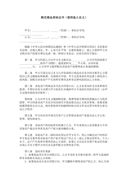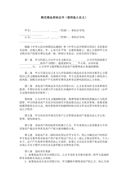Lesson 50,(通用12篇)七年级英语教案
Lesson 50,(通用12篇)
Lesson 50, 篇1
lesson 12teaching aims and demands : to demand ss to hear and speak and read these words correctly : review the words about food and vegetablesto demand ss to hear and speak the sentences correctly :can i help you ? what do we need ?.here’s the change.teaching materials : tape recorder ; some cardsteaching steps : step 1 greetingst: good morning, boys and girls. glad to meet you.step 2 presentationplay a guessing game (1)t: what am i going to buy? what do i want? just guess and say: "you want ..."(2)t= the teacher c= the computer ss= the studentsc: can i help you?(learn to say: "can i help you?")t: i want a sweater, sir. c: how about this one? ss: it's too small.c: how about this one? t: the size is ok, sir. but i don't like this color.c: what's your favorite color?t: (take out a purple sweater)i like this purple sweater. how much is it?c: it’s ...yuan (2) play a game: guess the price of the sweater.ss: how much is it?s1 : ...yuan .(if the price s1 guess is too low, the teacher will say: "up, up, up."; if too high, the teacher will say:'' down, down, down." each students has three chances to guess.)after the students guess the price right, the teacher puts on the purple sweater and asks the students "am i cool?"step 3 practice(1)listen to the dialogue.t: what have you heard in the dialogue?(2)listen to the dialogue and repeat it sentence by sentence.(3)practice in groups of three.step 4 consolidation(1)divide all the students into 4 groups: toy shop, clothes shop, fruit shop and food shop. put some goods in eachshop. get the students to do the shopping in groups. (2)ask the students to go to different shops and buy different things. step 5 homework listen to the tape & repeat for some times .finish off the activity book of lesson 12.
Lesson 50, 篇2
Teaching Objectives
Countable nouns & uncountable nouns and measure words
Language Focus
a piece of the other, another
Teaching Procedures
I. Organizing the class
Teacher: Good morning, class.
Students: Good morning, teacher
Teacher: Who’s on duty?
Student 1: I am.
The student will give a duty report about shopping.
Teacher: Very Good. Thank you very much.
II. Revision
Teacher: If you need some more food, where can you buy them?
If you need some more clothes.
Where to buy, in the shop?
Student 1 is to be a buyer.
We call him “customer”.
Student 2 is to be a seller.
We call him “shop assistant”.
Suppose you were a customer you want something to buy. Helping the customer in making a decision
1. What do you think of the color/style?
2. What size do you take/wear?
3. This T - shirt/skirt/woolen/sweater looks good/too big/too small/too tight/ just right on(正好适合) you.
4. You may try it on, the fitting room is over there.
5. It’s very fashionable, it looks wonderful on you.
6. It fits you very well.
7. I thinks it also suits you.
8. You look great/nice in red/in blue/in gray etc.
III. Leading - in
Get the students to understand the main ideas about .
Ask them to read the text and questions about Part 1.
1. Who's Ann?
2. Why does Ann need to buy some meat?
3. Who has bought it?
4. When did she buy it?
5. Did Ann buy sth. for her party?
6. What party?
7. How many friends of hers are coming for the party?
8. What else did Ann need?
9. Where?
10. Are the oranges still there?
…?
IV. Presentation
Get the students to know the word ‘buy’, past form ‘bought’. you can't have it in the following sentence.
“I have bought it for half a day.”
You should say “I have had it for half a day.” The second word “more” not a comparative degree, but sth you get again.
eg. —Is there anyone in the room?
—One more.
It means there is still one.
The word “have” in the text means “eat”.
eg. What did you have/eat for breakfast?
Get the students to master another usage of this word “have”.
eg. P.E teacher had his students trained just now.
V. Learn Part 1. 2. 3
Use these dialogues as models for revision. Get them to make up similar dialogues, and then give them 2 or 3 minutes to work in pairs.
Here is a dialogue for reference.
Shop assistant: Good evening. Can I help you?
Customer: Yes, would you please show me that sweater?
S: Sure.
C: It s very fashionable, isn't it?
S: Yes, it is.
C: But do you have a yellow one of the same style (风格)? I want it to match my jeans.
S: We do (强调)have yellow ones, here you are.
C: May I try it on?
S: Yes, please.
C: Oh, I think the color and the style suit me very well, but the size doesn’t fit me.
Why don't you show me a looser one, size M.
S: All right. There you go.
C: This is better, much better.
S: It looks great on you.
C: Thank you. I'd take it.
VI. Practice
Call out some pairs to act out the dialogues in front of the class.
Make sure they really understand the 1st 2nd 3rd part. Ask them to make new dialogues as they like.
VII. Exercise in class
1. have sb. do/have sb. done.
2. have sth. done.
3. help oneself to sth.
(1)You must have your hair cut.
(2)He has the horse trained.
(3) Mary! Help yourself to some beef.
(4) Help yourselves to some fish, Susie and Jack.
(5) Would you give me another cup of tea?
(6) Here are some/a number of pieces of news.
(7) It's a piece of cake.
这里有两层意是,其一是“一块蛋糕”;其二是“小菜一碟”,言外之意是“小事情”。
Ⅷ. Homework
1. Recite the dialogues in the text.
2. Make his own dialogue.
The design of the blackboard
need to buy… Ten people are coming for dinner.
need some more Help yourself to…
have to What delicious food!
Lesson 50, 篇3
Properties: Recorder, Overhead Projector.
Teaching Objectives:
1. Understand the text.
2. Learn some useful words and expressions.
Teaching Procedures:
I. Showily the teaching aims
II. Revision
Check the homework. Then revise the dialogue in Lesson 57. Ask the students to act out the dialogue. Study the new words in this lesson.
III. Leading in
Ask the students this question: There is a famous animal doctor in England. He wrote many books about animals, what’s his name? Let the students read the text and answer the question.
IV. Reading
Ask the students to listen to the tape and answer the question: Which animal did Herriot like best? Then go through the questions of Exercise 1 in the workbook. Make sure they can understand them. Ask them to read the story more carefully and discuss the answers to Exercise I in the workbook in pains. Check the answers with the whole class. Deal with any grammatical or lexical problems that arise.
1. make up one's mind to do something
He has made up his mind to study English well.
2. go on with something: Let’s go on with our lesson.
3. regard . . . as
He regards his teacher as his mother.
V. Reeling aloud
Play the tape for the students to listen and repeat. Use any methods that you think suitable: repetition by the whole class, groups, pairs or individual students. Then give out some key words and phrases. Let the students retell the story.
VI. Workbook
Do Exercise 2. The answers are: for, grow up, into, that, made up, mind, treat, Before, treated, heal, treating, At, at, on, regarded
Do Exercise 3. Let the students do it by themselves. Choose the best answer, then read the sentences together. Pay attention to the grammar. Let the students make up more sentences.
VII. Summary
Exercises in class
Fill in the blanks.
1. He made up his mind ________ (study) English well.
2.________(treat) large animals is hard work.
3. Ifs hard work ________ (treat) the dogs.
4. Please go on ________ (read) the text.
5. He grew up with a pet dog________ (name) Don.
6. The dogs ________ never________ (treat) when they became sick.
7. Everyday as he went to the farmers ________ (heal) sick animals.
Answers: to study, Treating, to treat, reading, named, were treated, to heal
VIII. Homework
1. Learn the phrases, make sentences with them.
2. Retell the story.
Lesson 50, 篇4
Step 1 Revision
Revise the dialogues in SB Lesson 34.
Check the homework.
Step 2 Reading
SB page 35, Part 1. Speech Cassette . Look at the street map on colour page iv and listen to Number 1: Ss trace the route as they listen . They check their answers in pairs using the reading text . The answer is : at the Zoo . Play the tape and listen to Number 2, then check the answer with the class. The answer is: at the post office . Repeat the procedure.
Step 3 Write and talk
SB page 35, Part 1. Ss write a puzzle. using the ones in Part 1 as a model. They can take any place on the map on colour page iv as their starting point. They work in pairs. Get some Ss to read out their puzzle for the whole class.
Step 4 Listening
SB page 35, Part 2. Wb , Ex. 1. Listening Cassette . Play the tape three times, if necessary. Ask the Ss to look at the map on page iv .
Listening text:
1 You are at C.Go along the road, and take the first turning on the left, the second on the left . Where are you?
2 You are at D . Walk along the street. Take the second turning on the right, and the third turning on the left . What can you see on your left?
3 You are at E . Walk along the street, and take the third turning on the left, the second turning on the right . Where are you?
The answers are: 1 at the train station,
2 People's Hospital, 3 at the bookshop/ the bus station .
Step 5 Workbook
Wb , E . 2-4.
Do Ex . 2 orally with the whole class . Ss may trace the route on the map on colour page iii and use the expressions of position to ask and answer questions .
T: Which way can you find to the tigers?
SA: Three ways , I think .
T: Please tell me one of the ways .
SA: Go into the gate, walk along the road and then cross the bridge, take the first turning on the left, go along the road. Then you can see the tigers there .
There are no unique answers to these questions . Teachers can encourage Ss to find more answers . For Ex. 3, let the Ss write the missing words into the blanks before practising the dialogues. The answers are: Excuse me; I'm sorry/ Sorry ; better; quite/ very far; 'd/ had; kilometres; shall/ can; better .
Ex. 4 is optional. If possible, get one of the Ss to draw the finished map on the Bb while the other Ss draw the map in pencil in the workbook .
Homework
Finish off the Workbook exercises .
Revise the new vocabulary and structures in this unit.
Lesson 50, 篇5
教学目的(Teaching Objectives)
(1)掌握重点单词和词组hurry up. go the wrong way, be tired。
(2)熟练掌握be going to 结构的用法
(3)能回答课文的问题并能根据上下文判断单词的意思。
教具(Properties) 教学磁带,图片和卡片。Properties: tape recorder, calendar. .
教学过程 (Teaching Procedures)
Step 1 Organizing the class
Greeting end a duty report
Step 2 Review
1. To say sentences according to the calendar about Charlie’s holiday plan.
eg. Charlie is going to catch the nine o’clock train to his uncle’s home. etc.
Step 3 Leading - in
T: Last lesson, we have known the students are going to have a field trip to mountain. Today we’re going to see what they met on their trip.
Do you think they have a good time? Are there any problems? (Encourage students to guess about their trip.)
Students Listen to the tape with their books closed and try to write down the problems. Call one student to write on the blackboard.
Step 4 Presentation
学生默读课文,了解课文大意。并对下列句子进行判断。
A: they go to the top of the mountain to have a picnic.
B: they have no problem getting there.
教师就生词和难点进行举例解释。
To draw a mountain on the blackboard, teach the phrase “on the top of” pointing to the top and “at the foot of the mountain” pointing to the loot of it “To have a picnic means to carry your food. and eat in out doors” “To trip over sth means to fall down because of sth”
e.g. I want to climb to the top of the mountain first.
Tomorrow we are going to have a picnic in a park.” “The boy trips over a lying tree.
Step 5 Practice
Students listen and read the article.
Then they ask and answer about the problems in pairs “What s the matter with Jill?”
“She often goes the wrong way.” etc.
并就教科书78页的练习2进行讨论。然后两人一组问答练习。
Step 6 Practice
教师将课文第七页的1,2,3,4,5副图放大后挂在黑板上。告诉同学这就是当时爬山的情景。
Students guess what the people in each picture are going to say. Then check the answers.
Then students try to find ways to help them. They work in small groups.
最后教师让学生合上课文,根据图片复述课文。
If time permits, they act it out as a role play.
Step 7 Exercises in class
Ed trips over his shoes, so he has to 1 . Jiang Wei is very tired, he wants to 2 . Li Mu has too many things in his bag and it’s too heavy, he needs 3 . Katy wants to hike quickly, she always says 4 . But Jill often goes 5 .
Answers:1. Wear his shoes 2. have a rest 3. help 4. hurry up! 5. the wrong way
Step 8 Homework
1.Do the exercise 2 in page 78 of the textbook
2.To make a role play according to the pictures.
Step 9 The design of the blackboard
Lesson six
be going to
be doing
the word and phrase.
the pictures of the text.
Lesson 50, 篇6
教学目的
掌握英文字母A-G的正确拼读及书写。同时听懂并学会运用一些简单的日常用语。
教学内容
1.字母 A~G。
2.句型:初步理解以下句型:1)What’s your name? 2)My name is…
3.日常交际用语:打招呼用语(Greetings):1)Hello! 2)Good morning. 3)Nice to meet you!
教具
录音机;姓名卡片一张(上面写着教师自己姓名的汉语拼音);字母卡片A~G(含大、小写);字母组合卡片(Part 3);划有四线格的小黑板(为教字母的书写准备)。
重难点
掌握A,B,C,E,D,F,G的读音、书写;运用简单的问候语进行日常交际活动。
课堂教学设计
Step 1 Presentation (10 mins)
1.教师用英语说:Now class begins.然后借助手势让学生起立,用英语向学生问好。
T:Good morning,class!
S:Good morning,teacher!
然后用英语说:Sit down,please.并同时做出请学生坐下的手势。
教师向学生解释 Good morning的意思,并告诉学生下午好应说“Good afternoon”。用手势介绍teacher和class这两个词,然后要全班用相同的语句来应答。
T:Good morning,class!
Ss:Good morning,teacher!
T:Good afternoon,class!
Ss:Good afternoon,teacher!
反复训练几次,直到学生练熟为止。教师可以反复重复:Stand up.及Sit down,please.等用语,让学生们做出相应的动作,直到确信学生已经能听懂为止。
2.教师告诉全班学生:We’re going to learn Lesson One today.并用中文(今天我们学习第1课)重说一遍,让学生听懂即可,并板书Lesson One在黑板上。教师拿出事先准备好的写有自己姓名的汉语拼音卡片,指着自己,对学生说:My name is.
重复几遍后,问一位学生:What’s your name? 如果学生仍不明白,可反复借助手势,引导学生答出他/她的名字。
3.播放对话演示录像(见媒体素材视频类:对话演示 part 1)
4.让学生看Lesson One中的两张图,教师可对图中人物及对话做些解释,也可请学生描述在图中能看到什么人,这些人在干什么。放录音,第一遍学生只听不读,从第2遍起跟读,反复几次,并要求学生认真模仿。
5.播放Part 1的课文对话跟读(PowerPoint文件)中的的音频(见媒体素材课文对话跟读),让学生反复跟读。
Step 2 Drill (6 mins)
l.教师说 I’m your teacher(请自己并解释)领读teacher词。
2.师生对话,操练数遍。
T: Good morning, class.
S: Good morning, teacher.
3.先让一学生上讲台当教师向全班问候,然后让几个学生分别当教师进行操练。
S: Good morning, class!
C: Good morning, teacher!
Step 3 Practice(8 mins)
1.将全班分为两人一组,仿照图中对话,进行练习。数分钟后,请几组同学到前面演示。教师从第一节课起,就要鼓励学生敢于表演,表演时声音洪亮,并一定要伴有动作(如本课中招手、握手等),以增强交际效果。
2.播放动画:Greeting(见媒体素材日常交际用语:Greeting),先整个观看动画一遍,然后教师把声音关闭,让学生根据场景模仿动画。
Step 4 Presentation(10 mins)
1.教师拿出A~G的英语字母卡片,教学生认读字母。在出示字母卡片时,应按字母表顺序。并说明英语字母有大、小写之分。教字母读音时,要求学生认真观察教师口型变化,仔细模仿。
2.放字母的录音,可反复播放几次。先是由学生集体跟读,在学生有一定实践的基础上,叫几行学生依次朗读。从一开始就要把字母朗读的两种语调教给学生,即升调和降调。对于在开始阶段学生出现的一些读音上的失误,如果误差不大,可先不予逐一纠正,表扬发音好的学生,鼓励其他学生也积极模仿。在本课字母中,C、f、g这3个字母的读音,教师在教学时,放慢速度,多做示范;必要时,可走到教室中间或后面,以使坐在后面的同学看得清,听得真,有利于模仿。
3.播放动画:学字母(见媒体素材:学字母),更形象地教学字母A—G,同时可以吸引学生的注意力。
4.拿出事先准备好的划有四线格的小黑板,教师在小黑板上逐一示范A~G这些字母的大、小写格式、笔顺,以及各个字母在四线格中所占的位置。并简要告诉学生英语字母有书写体和印刷体之分,要求学生依照书写体的示范去书写字母。
5.让学生拿出练习本抄写,要求学生书写工整。并按笔顺仿写。教师检查,及时纠正学生在书写英语字母时出现的笔顺、格式处理不当的错误。
Step 5 Consolidation (5 mins)
1.拿出事先准备好的字母组合卡片,让学生读 Part 3中的字母:CD BC AD CBA CAAC ABC BBC CBC BA等。可以放录音让学生跟读。
2.听写A-G大小写,可以按顺序念。
3.要2名同学师将课文第一部分对话练习一遍。
Step 6 Workbook ( 5 mins)
1.先全班做Ex. l,Ex. 4,然后个别学生认读,教师纠正其发音。
2.听写字母,不按顺序单独中听写字母。
Step 7 Homework
1.听录音带,并跟读本课所学的日常用语;反复操练Part 1的对话,并能背诵。
2.书面做Ex. 2,Ex. 3
交际用语讲解
1.Good morning,class!同学们,早上好!
句中class是教师对全班同学的称呼。类似的表达法还有:boys and girls;everyone等。例如:
Hello,everyone!同学们好!
Please repeat after me,boys and girls.同学们请跟我读。
2.Good morning,teacher!老师,早上好!
Good morning.早安!/早上好!
这是西方人在上午见面时打招呼的用语。一般从早晨到中午均可使用。其应答用语相同。例如:
A:Good morning!
B:Good morning!
有时在熟人之间可略作:Morning!
注意,在英语中“王老师”,“李老师”等不可称为:Teacher Wang;Teacher Li. 这是因为teacher一词不能放在姓氏前作称呼语。如果是男老师,可称为:Mr. Wang或Mr. Li,如果是女老师,可称为:Ms Wang或Ms Li。但Good morning,teacher!(老师,早上好!)这个句子还是可以接受的。
Lesson 50, 篇7
Step 1 Revision
Revise the dialogues in SB Lesson 34.
Check the homework.
Step 2 Reading
SB page 35, Part 1. Speech Cassette . Look at the street map on colour page iv and listen to Number 1: Ss trace the route as they listen . They check their answers in pairs using the reading text . The answer is : at the Zoo . Play the tape and listen to Number 2, then check the answer with the class. The answer is: at the post office . Repeat the procedure.
Step 3 Write and talk
SB page 35, Part 1. Ss write a puzzle. using the ones in Part 1 as a model. They can take any place on the map on colour page iv as their starting point. They work in pairs. Get some Ss to read out their puzzle for the whole class.
Step 4 Listening
SB page 35, Part 2. Wb , Ex. 1. Listening Cassette . Play the tape three times, if necessary. Ask the Ss to look at the map on page iv .
Listening text:
1 You are at C.Go along the road, and take the first turning on the left, the second on the left . Where are you?
2 You are at D . Walk along the street. Take the second turning on the right, and the third turning on the left . What can you see on your left?
3 You are at E . Walk along the street, and take the third turning on the left, the second turning on the right . Where are you?
The answers are: 1 at the train station,
2 People's Hospital, 3 at the bookshop/ the bus station .
Step 5 Workbook
Wb , E . 2-4.
Do Ex . 2 orally with the whole class . Ss may trace the route on the map on colour page iii and use the expressions of position to ask and answer questions .
T: Which way can you find to the tigers?
SA: Three ways , I think .
T: Please tell me one of the ways .
SA: Go into the gate, walk along the road and then cross the bridge, take the first turning on the left, go along the road. Then you can see the tigers there .
There are no unique answers to these questions . Teachers can encourage Ss to find more answers . For Ex. 3, let the Ss write the missing words into the blanks before practising the dialogues. The answers are: Excuse me; I'm sorry/ Sorry ; better; quite/ very far; 'd/ had; kilometres; shall/ can; better .
Ex. 4 is optional. If possible, get one of the Ss to draw the finished map on the Bb while the other Ss draw the map in pencil in the workbook .
Homework
Finish off the Workbook exercises .
Revise the new vocabulary and structures in this unit.
Lesson 50, 篇8
教学目标
学会复数物品的颜色描述。会描述一件衣服。
教学用具
同L49
教学步骤
Step 1 Review
上节课学过的十种颜色。可用上节课的课件。
Step 2 Presentation
用做好的课件呈现Part 1 第一部分。教单词 sweater light 呈现下列词组 light red / blue / green / yellow... a light blue sweater light blue sweaters
借用媒体,老师重复课文。然后老师问,同学答。在通过pair work和group work将课文背熟。
用做好的课件呈现Part 1 第二部分。方法同上。
听录音并跟读。
Step 3 Drill
1.练习句型 How many n+s are there? There are …
让学生练习下一组对话
How many people are there in your family? There are three
How many students are there in our class? There are 45.
How many girls are there in our class? There are 20.
How many boys are there in our group? There are 5.
2.讲解、练习
look+adj
You look very happy today.
Your sweater looks very nice.
She looks sad today. Why?
You look very well toady.
事先让一位女生穿一件彩条或颜色较多的毛衣。课上可让这位同学站到讲台上和老师示范对话。
one & ones 用来代替刚提到的同一种可数的东西:
I haven’t a pen. Can you lend me one?
The question was a difficult one.
ones 是复数形式
There are one long writing-table and two small ones in the office.
Have you any books on farming? I want to borrow ones.
There +be (is, are) 用来引起一个句子,表示“有”“存在”等:
There are pens and pencils in my pencil-box.
There are many books in my bag.
There is a clock on the desk.
There is a blackboard on the wall.
like 作介词,
like 像
I don’t do it like this.
Don’t throw it like this.
I want to speak English well like you.
3.单词 want: I want a new book. I want a cup of tea.
Listen to the tape and repeat.
4.初步了解否定意问句。
Can’t you see it? Yes, I can.
Can’t you hear me? Yes, I can.
Isn’t it Monday? Yes, it is.
可译为难道…表示提问人心中认为是肯定的。不要过分强调回答。
Step 4 practice
练习 P154 ex4
Step 5 consolidation
描述一下你同伴的衣服。
Homework
Blackboard handwriting
want
light light red / green
sweater a light red sweater
How many n+s are there?
There are …
look+adj
The sweater looks nice.
one & ones
Lesson 50, 篇9
lesson 15class opening1. greetingteacher: hello, class. how are you doing today? it’s a lovely day, isn’t it? are you ready for the class?2. ask this question: who’s on duty? then listen to the student’s report.make sure the next student for “ who’s on duty?” knows who he or she is for next time.from today on, you can arrange a student to give a duty report every day.3. ask volunteers to act out the dialogue in lesson 44. sing a song “a plane is fast.”sunday, monday, tuesday, wednesday, thursday, friday, saturday.make a plan.what do you think of it?step1: presentation1. play “what day is it?’2. discuss: do you like to make plans for your life?step2: drillt: (holding a book) what do you think of the book?s: it’s ok.t: (holding a pencil case) what do you think of the pencil case?s: it’s nice.t: how about the picture?step3: practice1. books closed! ask this question: what does li ming change in the plan? play the audiotape.2. check the answer.3. play the audiotape as the students follow along in their student books.4. students listen and repeat.5. get the students to make up new dialogues in pairs.6. explain “ write home”. it means write a letter to family members.plan of our tripstep4: presentationshow the students a calendar to review the words: sunday, monday, tuesday, wednesday, thursday, friday and saturday.step5: practice1. play the audiotape as the students follow along in their student books.2. ask and answer.students a: what do they on monday?student b: they leave shijiazhuang and arrive in beijing.student a: what do they do on tuesday?3. explain that danny and jenny shop in shijiazhuang means danny and jenny go shopping in shjiazhuang.class closing read the story “li ming goes to the airport” the reader in the activity book and audiotape
Lesson 50, 篇10
(一课时或两课时)
教学目标
掌握语音;谈谈自己对四季的看法,说说自己最喜欢那个季节,并说明理由。
教学用具
录影机、媒体设备。
教学步骤
Step 1 Revision
四季和12个月份。
Step 2 Presentation
老师朗读这些句子,朗读两遍,重读动词及反意部分。
It’s fine today, isn’t it? Yes, it is.
You’re from Japan, aren’t you? Yes, I am.
They are waiting, aren’t they? No, they aren’t.
He’s a middle school student, isn’t he? Yes, he is.
She is at home now, isn’t she? No, she isn’t. She is at school.
It was Sunday yesterday, wasn’t it? Yes, it was.
Jim knows the way Australians speak, doesn’t he? Yes, he is.
Han Meimei knows Jim a lot, doesn’t she?
They were watching TV yesterday evening, weren’t they? Yes, they were.
You like spring best, don’t you? No, I don’t. I like summer.
将这些句子用投影仪打出,让学生观察,并总结反意问句的构成,以及它的回答方式。
Step 3 Drill
然后可采用老师说主句部分,由学生练习缩略部分的方式练习。练熟后由学生说主句部分,老师说从句部分,直至练熟。也可在黑板上出一部分句子,写出主句部分,让学生写反意部分。目前只让学生练习前肯定后否定的反意问句,回答部分不必多花时间。
听录音,并跟读。
Step 4 Practise pair work
联系Part 2 可让学生自由发挥,如两人谈谈北京的四季,和你家乡的季节,但主要练习反意问句及其回答。
教单词:true near nearly like unlike opposite
Step 5 Listen and repeat
Open your books and do Exercise One, Lesson 44
Pay attention to these pronunciations.
Read the words again.
T: Now let’s do Exercise Two. Listen to the tape and choose the correct answers on Page 134.
Then check the answers together.
Step 6 Consolidation
1.看图并谈谈北京的四季。一个学生可重点谈一个季节。练习Lesson 43 Part3.
2.让学生编一个对话,谈谈自己所喜爱的季节。引出一个十分有用的句型:That’s true.
仿照Lesson 44 Part3.
A: Which season do you like best, spring, summer, autumn or winter?
B: That’s an easy question. I think I like spring best.
A: Why?
B: Well, I like travelling. You can do a lot of sightseeing in spring. What about you?
A: Can you guess?
B: You like winter, don’t you?
A: Yes. How did you guess?
B: Because you like skiing.
A: That’s true, but I like summer better than winter.
B: Why?
A: Because I can have a long holiday in Summer then.
3.Listen Lesson 44 Part 4 Read.
把你听到的填写在下列表格中,对比中国,美国和澳大利亚。
Spring
Weather
Summer
Weather
Autumn
Weather
Winter
Weather
China
Mar—
May
Warm
England
Amer-
ica
Mar—
May
Austra-
lia
Keys
Spring
Weather
Summer
Weather
Autumn
Weather
Winter
Weather
China
Mar—
May
warm
short
June—
August
hot
Aug.—
Nov.
quite warm
Dec.—
Feb.
very cold
England
Mar.-- May
longer than in China and USA
Not too hot or too cold
Amer-
ica
Mar—
May
A nearly the same as China.
Austra-
lia
Dec.—Feb.
The seasons are opposite of China.
June—Aug.
Ask the students to look at the two pictures in students Book and describe the pictures in their own words.
Let them talk about the weather in China, in England, in the U. S. A. and in Australia.
4. Go over Checkpoint 11
A: Grammar
1. disjunctive questions 2. the prepositions: in, on and at
B: Useful expressions
1. turn green/yellow/… 2. this year/month/… 3. the next year/month/…
4. be different from 5. What is the date today? 6. What’s the weather like?
Step 7 Exercises in class
Listening practice.
Listen to a story and try to answer the following questions.
Everybody talks about weather. “Isn’t it a nice day?” “Do you think it will rain?” I think it s going to snow. These are common ways of starting a conversation in England.
Many people think that they can tell what the weather is going to be like. But they hardly ever agree with each other. One man may say, “Do you see it is cloudy in the east? It’s going to rain tomorrow.” Another man will say, “Yes, it’s cloudy in the east. We’re going to have fine weather tomorrow.”
People often look for the weather they want. When farmer needs water, he looks for something to tell himself that it's going to rain. When people play in a park on a rainy day, they are sure that the weather is going to be fine soon. They even sit eating their lunch while it rains.
Most people listen to what the weatherman says on the radio. But he doesn’t always tell them what they want to hear. Sometimes he makes a mistake, but he is still right more often than anyone else.
Questions.
1. How do English people start a conversation?
2. Do many of them think they can tell what the weather is going to be like?
3. Why do they hardly agree with each other?
4. What kind of weather do people think it’s going to be if they go out to play in a park in the rain?
5. Who is right more often about the weather?
Keys:
1. They usually talk about the weather.
2. Yes, they do.
3. Because each of them is so sure of himself that only he knows about the weather.
4. They think it s going to be fine.
5. The weatherman is.
Step 8 Homework
1. Make up a new dialogue according to Exercise Three.
2. Write about the weather of four seasons in China.
3. Read the text fluently and try to recite it.
4. Review Checkpoint 11 and the whole unit.
5. Go over disjunctive questions.
Step 9 Blackboard Handwriting
Lesson 50, 篇11
lesson 18teaching aims and demands : to demand ss to hear and speak these phrases correctly:go to the seaside, go camping, go swimming, go fishing.to demand ss to hear and speak these sentences correctly:what will do in the summer? i’ll play the violin / go to the seaside / go camping… can listen and sing the song: my little aeroplane.teaching materials: tape recorder; some cards.teaching steps: step 1 warm-up/ reviewto review the phrases: play the violin, play the piano, draw pictures.step 2 learn to say 1. the teacher asks: what will you do in the summer? do you want to know the friends on the book will do in the summer? look at the pictures of page85.2. listen to the tape and repeat.3. practice the phrases by “passing, guessing, finding” game.4. practice the sentences by “asking and answering.” what will you do in the summer? i’ll…step 3 learn to sing.1. listen to the tape.2. to learn the words.3. listen and sing the song.step 4 listen and numberplay the tape for the ss to listen and number.play again for the ss to check their answers . step 6 homework finish off the activity book of lesson 18.
Lesson 50, 篇12
Step 1 Revision
Greet the class. Ask What's the date today?
Help the Ss to answer, e. g. It's September 2nd, 1996. Keep doing this in every lesson from now on.
Revise the names of objects by playing the What's in my bay? game. Collect a number of familiar items, discuss their colour, weight, size, etc. with the Ss and put the items in a bag. Then get the Ss to describe the items in the bag one by one.
Revise I'm sorry, it's broken and It doesn't matter and practise dialogues with the Ss using the items.
Step 2 Presentation
Write on the board: Lesson Two, the second lesson.
Say Today let's learn -the second lesson. Repeat the word second.
Teach long and short by showing the class two rulers, or pieces of wood. Say This ruler is long. This one is short. Ss listen and repeat. Ask Is this ruler long or short?
Teach tall in the same way, by drawing two boys, one tall and one short, on the Bb. Revise a piece of paper and teach a big/small piece of paper in the same way. Note the position of big/small before piece, not paper. Teach two/three pieces f paper (never papers).
SB page 2, Part 1. Speech Cassette . Ss listen and repeat. Then books closed! Point to a ruler/piece of paper/ picture on the Bb and ask What's this? Get the Ss to say It's a long ruler/big piece of paper/tall boy, etc.
Step 3 Presentation
Ask individual Ss Excuse me! May I borrow a ruler, please? Help them to answer Certainly! Here you are. Then say Thanks. Oh, sorry, this is short, Do you have a long one, please? Help the Ss to answer Oh, yes, I do or Sorry! I don't.
Step 4 Practice
SB page 2, Part 2. Speech Cassette . Ss listen and repeat, then practise in pairs. Contrast borrow (for an item that will be returned after use) and have (for an item that will not be returned ).
SB page 2, Part 3. Ss make three new dialogues.
Get some pairs to act theirs out.
Step 5 Listening
Read the following listening text. Demonstrate what the Ss have to do as you speak. Do not move on until the Ss have carried out an instruction.
Listening text
Do you all have a piece of paper like this? Hold it like this, and fold it in half like this.
Write your name in Chinese on one side, here; on the other side, write your name in English.
Begin your family name and your first name with a capital letter - a big letter. But use small letters for the other letters in your name.
When you finish writing your name, put the piece of paper on your desk.
Put it on your desk so I can see your names in English!
This will help me to know your names!
When the Ss have finished the exercise, talk to some of the Ss, like this: Hello, (Name). How are you?
Step 6 Workbook
Wb , E. 1-3.
Ex. I is a written exercise. The answers are: a bottle of milk, four small pieces of paper, two long rulers, five bottles of water, eight pieces of bread, six small bags of tea, one big bag of rice, two kilos of fish.
Ex. 2 may be done orally in class. The answers are: 1-d, 2 -e, 3 -b, 4 -a, 5 -c.
Ex.3 may be done orally first, and then in writing. The missing words are: Excuse me;
Certainly; this one; Thanks: Do you have a small one?; I don't.
Homework
Finish off the workbook exercises.

















